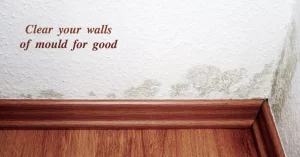
Mould spores are all around us, and all it takes for them to become active is a little moisture and warmth. A mould colony appears out of nowhere. Growth can occur, on any surface, as long as the conditions are favourable from wood to tile to sheetrock walls. Mould that grows on your walls can be black, green, brown, or white. If the colony is substantial, it is critical to identify the type of mould development before beginning the cleaning process in order to establish the overall health impacts on you and your family.
There are three general types of mould that are most commonly found in a household and those are:
- Allergenic mould is the easiest to clean and you can use disinfecting products only.
- Pathogenic mould cleaning is similar to an allergenic one. However, large colonies will need to be treated by professionals.
- Toxic moulds should be addressed as soon as possible. They should always be treated by professionals and all materials used during the process should be disposed of.
- You notice a musty odour in your home. The odour indicates a mould problem that must be treated.
- You have ignored a dripping faucet or a leaking roof that has caused moisture.
- A wall that feels soft or damp to the touch could indicate inner mould growth that will soon be visible on the surface. Discolouration of wallpaper and paint can be noticeable too.
- Because of the house’s inadequate ventilation, there is moisture collection that takes a long time to evaporate from the walls. Make sure all vents are properly working.
- Mix a cleaning solution – Combine 1 part dishwashing liquid, 10 parts bleach, and 20 parts water in a small bucket. In a spray bottle, combine 1 tablespoon of dishwashing liquid, 1/2 cup chlorine bleach, and 1 cup of warm water to clean a small area of the mould. The dishwashing liquid allows the solution to adhere to the wall for a longer period of time, killing the mould spores.
- Wear protection – When cleaning mould, wear old clothes that you don’t mind getting splattered with bleach and can be rinsed in hot water to eliminate any mould spores that may have landed on the surface (best to throw them away). Put on a face mask (N-95 is recommended), safety glasses, and gloves.
- Make sure the area is well-ventilated – You should always make sure the room you are working in is very well-ventilated. Open all windows and place fans around the room to improve airflow. It is best to do this type of cleaning on a warm day when you can leave doors and windows open for a couple of days or until the smell is gone.
- Apply the cleaning solution to the affected area – Use a spray bottle or a sponge to apply the cleaning solution to the affected surface. It is advisable to start cleaning moulds at the bottom and work your way up. This prevents spores from spreading and stains from streaking on your wall. To avoid drywall damage, the surface of the wall should be completely wet but not saturated. If the mould is towards the ceiling, always use a strong stepladder or a clean sponge mop to administer the solution.
- Dry and check – Do not wipe the cleaning solution away – let it air dry. Once the area is dry, check for any remaining stains or spores. Repeat the process if needed.
As soon as mould is identified, it should be eradicated as soon as possible. Even if you don't observe mould development, there are warning indications of a future mould infestation that can help you keep the colony under control. To help maintain your household healthy, watch out for these signs of mould growth:
Here is how you can approach mould cleaning in the best way possible:
Pro tips on getting rid of mould for good:
Chlorine bleach is the most effective home-removal product for killing mould spores. However, it is toxic and many people nowadays try to avoid using it. If the infestation is small, you can use distilled white vinegar or hydrogen peroxide to kill the spores.
Distilled white vinegar is acidic enough to slowly break down the structure of the mould and kill it. However, dark stains may remain and require additional scrubbing with a household cleaner. Spray the mould with 100% distilled white vinegar, wipe away the mould with a microfiber cloth or sponge, and allow the area to air dry.
Hydrogen peroxide will kill mould and lighten stains but it works more slowly than chlorine bleach and may require multiple applications. Spray the mould with 3% hydrogen peroxide solution (first-aid grade), wipe the area with a sponge, and all the walls to air-dry.
To avoid mould and mildew growth, check your plumbing, roof, faucets, and other sources of moisture that may be malfunctioning and creating the perfect conditions for mould growth.
